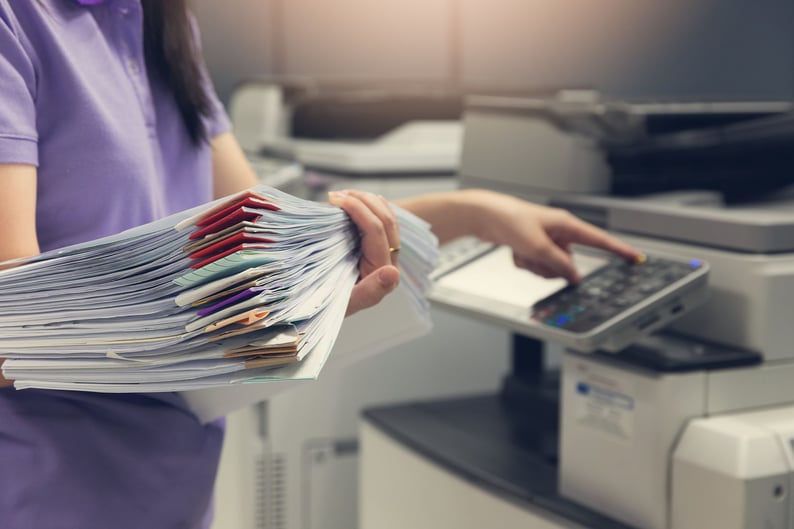Whether it’s to save money, increase productivity, or help the environment, many business owners are taking a serious look at going paperless. Going paperless is not that difficult to do and in the long run, it’s certainly better for your accounting firm’s bottom line. If you are interested in transforming your firm into a paperless office, there’s no better time to start. In this post, we go over the benefits of going paperless, steps for going paperless, and tips for paperless organization.
The benefits of going paperless
Save money

Recent studies show that the average US worker uses 10,000 sheets of paper per year, and as much as 70% of a company’s total waste is in paper. Paper is one of the largest costs for US businesses, with around $120 million spent on printed documents each year. That doesn’t even include all the other related supplies you have to buy to keep your office running: toner, ink, envelopes, staplers and staples, copiers, fax machines, and more. When you transition to a paperless office, all of those expenses disappear. And once you don’t have any paper to deal with, you also won’t need file cabinets and storage boxes.
Save time
You and your employees will waste less time every day with tedious tasks such as printing, faxing, mailing, and copying, freeing you up to concentrate on more important work and get things done faster. Plus, with a paperless system you won’t have to go hunting through file cabinets for the documents you need, you’ll have access to what you need in seconds.
Improve workflow

When you take your firm paperless, workflow and collaboration between team members becomes more simple. You can share documents and spreadsheets and work on them together simultaneously—all of your information is right at your fingertips no matter where you are. Access client data in the office or at home, on your computer or your mobile device. You don’t have to have physical documents in front of you to progress a client’s case. When you’re able to work more efficiently, clients will notice the difference in the quality of speed of service you can provide.
Steps for going paperless
Once you’ve decided that you want your accounting firm to move in a paperless direction, these are the steps for going paperless.
1. Invest in cloud-based software

There are many choices on the market for cloud-based accounting software, storage platforms, mobile apps, and more that help facilitate a paperless practice. Most of them utilize e-signature tools, which have been legally binding in the United States since 2000. However, note that many IRS forms still do not allow e-signatures, so it’s important to know when a more traditional method is required.
2. Scan in essential documents
To eliminate the bulk of your paper waste, you must turn all of your documents to digital form. This will be time-consuming up front. You’ll need to invest in a scanner that meets your needs.
3. Shred any old documents

Once your documents are scanned and stored digitally, you’ll need to eliminate the old documents. Shredding is the safest and most secure way to destroy documents you no longer need but that contain sensitive and private information. For extremely large shredding jobs, you can hire a professional service that will do regular pickups and take care of all the shredding.
4. Create a robust document management system for storage
It’s extremely important that your firm has a sound document management system. Backing up your files is one of the most important steps in creating a paperless office. Do not shred or get rid of any of your documents until you have backed them up. Even though your documents may be secure in digital storage, a computer crash or other malfunction can erase important files. That’s why it’s critical that you have a backup plan in place.
The most popular way to back up files is via cloud storage services. Just be sure to do your research to find a reputable cloud provider—like Canopy! Since cloud services are not directly connected to one computer, none of the documents you keep in the cloud will be impacted if your computer crashes.
Alternatively, you can back up your files on an external hard drive. Because external hard drives are portable storage devices, you can keep your copied information in a physical location completely separate from your computer if you choose. Simply copy your information to the hard drive and keep it in a secure location.
5. Reduce small paper waste

There are countless ways of cutting down paper within your practice, outside of digitizing documents. For example, you can take notes on your computer rather than use notebooks or sticky notes. Canopy enables you to add notes to your cases right in the software—you won’t need a separate place for note-keeping.
Another way to cut down on paper is to bill your clients electronically, a feature that clients really love since they can pay with the click of a button. Canopy offers online billing and invoicing to make your life easier and your clients happier.
Tips for paperless organization
Going paperless is a great way to clean up your office space and increase efficiency in your accounting firm, but it requires thoughtful organization. When you store documents in the cloud everyone in your firm will have access to the same files, and the files will be updated in real time. Folders in the cloud can become as messy as the overflowing file cabinet in your office if every team member is using their own system to organize and name those files. To optimize the efficiency going paperless can bring to your practice, you need to standardize your system of organization. Here’s a look at how to do that:
Create main folders
To get started setting up your organization structure, create main folders. Choose whether you want your main folders to be sorted by clients’ names, types of cases, types of files, or another category depending on which makes the most sense for your practice. The categories should be broad enough that each type of document you use can find a home under that umbrella. Just be sure to only choose one structure for the main folders. Things will quickly become disorganized if everyone adds a folder each time they need to file something new.
It’s good to keep in mind that your hierarchy may change depending on which cloud software you use. Canopy, for example, stores files by client.
Set a hierarchy of files

After you’ve created the main folders, decide how to structure your file tree or hierarchy of files. This system should be similar to what you would find using document storage on your desktop. Within the file tree, folders and topics should narrow and get more specific.
For example, you may have this file tree: Offer in Compromise > Forms > Form 433-A
When deciding the hierarchy, it’s a good idea to think of how a physical filing cabinet works. If you would never file a document in a certain file in your filing cabinet, don’t file it there in your paperless system either.
Stick to one naming convention
Once a hierarchy is established, consider how files are named. Because every team member will be using the same filing system, it’s imperative that you put some thought into what the naming system should look like for ease of use across the team. There should be a uniform way for naming new files. You will have a difficult time finding the correct, most updated version of a file if there are several variations floating around.
For example, if you were looking for a power of attorney for a specific client, you wouldn’t want to sort through “Sarah Smith POA,” “POA - Sarah S,” “Smith Power of Attorney,” etc. Pick one format for naming and stick to it.
Get everyone on the same page

After you decide on a paperless filing system, call a meeting or send an email to get everyone on the same page. Increased transparency and ease of collaboration are two of the main benefits of going paperless, but it becomes a moot point if nobody knows how to find the files they’re looking for, or if they can only find outdated versions.
When your paperless system is running smoothly, any team member in or out of the office should be able to find the files they need, hassle-free. If finding a specific document becomes a frenzy in the office to ask who filed what and where, it’s time you restructure your system.
Taking your accounting firm paperless is easier with the help of a cloud-based practice management software like Canopy. Sign up free to see how our full suite of services can help you today. 








Get Our Latest Updates and News by Subscribing.
Join our email list for offers, and industry leading articles and content.